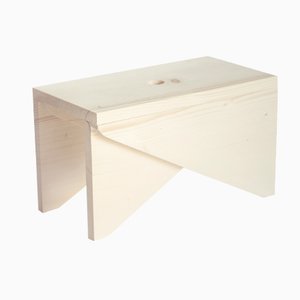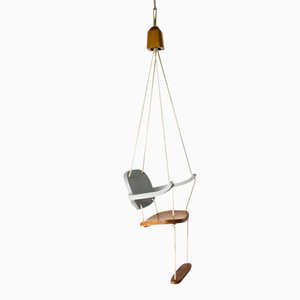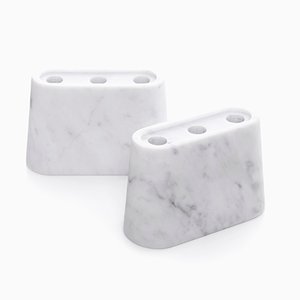Why Antonio Aricò is a designer you need to know now
Sense & Sensibility
There’s a range of straightforward, even sensible reasons to consider the work of Italian designer Antonio Aricò. His furniture collections—all created in the last five years, since he launched his eponymous studio—are handcrafted in Italy to the highest standards and built to last using solid beech and wenge woods. The look is chicly essentialist; the natural quality of the wood shines through in generously proportioned silhouettes, signaling that these pieces are timeless and special and will last for generations. No doubt, Aricò’s designs are as fine as any out there.
But there’s something more that sets Aricò’s work apart—an aspect that’s made this upstart one of the most sought-after young designers today. Beyond the pure, outstanding quality of his work, Aricò has been endorsed by many of design’s most respected thinkers and tastemakers—Li Edelkoort, Rossana Orlandi, Maria Cristiana Didero, Silvana Annicchiarico, and Andrea Branzi, among others—because the story that his pieces tell hits an emotional chord that’s at once unique to him and indicative of the most promising trends in contemporary design. In a world fueled by novelty and ephemerality, Aricò’s success is built on a deep-seated respect for tradition and an unwavering commitment to using design to find meaning. Today’s design connoisseurs love Aricò because he’s all about originality, passion, and authenticity.
Aricò (b. 1983) grew up in Reggio, a town in the breathtaking Calabria region of southern Italy, in a close-knit, multi-generational family of woodworkers whom he describes as “a tribe of creative people full of genuine values and enthusiasm for life.” After focusing on science in high school, he decided to go north to the Politecnico in Milan to study industrial design, because, as he explains, “it applied both creative and scientific approaches to the world of objects and consumerism—which seem to have such a peculiar and significant impact in contemporary society.”
He left his home in the south with high hopes about how design can make the world a better place. But by the time he found employment as a junior designer in large studio in Milan in 2008, he began to feel, in his words, “disillusioned” by the empty posturing that dominated his profession. He says, “Many in the design field appeared to my eyes more like intellectuals and promoters of their egos, rather than humble workers concentrated on the practical and ethical matters of this discipline.”
When he just couldn’t take it anymore, Aricò decided to move back home to be with his family, to regroup and feed his soul. Although he wrestled with feelings of failure, his mind remained active as he developed a checklist of what he would do differently if he were to start over.
“I began to realize that ‘reality’ was much more basic than the thoughts I had during my years of studying. You have to follow your instincts; this is the only way to express ideas in the most affective way. So I stopped thinking about all the technical and industrial constraints that the Politecnico taught me, and I started to use my own method in representing and visualizing design ideas.” That was not all he realized: ““I discovered,” he says, “that apart from being a good designer, it’s really important how you present your work within the international creative scene—to narrate your story and make yourself a kind of subject within your designs.” Aricò began to understand that the personal is often universal.
Aricò’s family, and especially his expert craftsman grandfather, would form the foundation of his new narrative. “My Nonno represented something that I always had in front of me, but that was far from the models that they teach you at university. I realized, indeed, that he was what I always wanted to be.” So he went to work side-by-side with his grandfather, not only creating a new collection of furniture in the family workshop, but also reinventing his career. Titled Back Home, the new collection debuted at Ventura Lambrate during Salone in 2012 to significant accolades.
“It was really surprising, that year in Milan,” Aricò recalls. “Everyone was talking about self-production and about the ‘makers’ movement. I was there with my Nonno, and—without really planning it—I was speaking the same language of Italian art-craft roots, tradition, and identity. That was the first chapter of my new ‘old’ story. And I believe that that exhibition with my Nonno was a gift from destiny and from my desire to tell the story of my family.”
Just like that, Aricò’s career took off. “Many galleries and institutions started to call me to design new pieces for different exhibitions, and the press was really fascinated by the story,” he says. “[Trend forecasters and curators] Li Edelkoort and Philip Fimmano talked about my adventure on Trend Tablet. But more than everything else, I was happy to be able to show my own approach to this discipline; my own way of representing the unique aesthetic of my ideas.” In the few years since that auspicious exhibition, Aricò has secured ongoing commissions from major Italian brands like Seletti and Alessi, and he’s been invited to showcase his work and discuss his practice at institutions and expos around the world, from Australia to Israel and Sweden.
The joy and charm that Aricò exudes in his storytelling also radiates from the finished products. Take for example his most recent projects for Alessi, Viva Napoli and Petite Mariée. The former is series of pizza plates featuring illustrations of the classic, 17th-century commedia dell’arte “pulchinella” clown figures making pizza in front of Mt. Vesuvius. Stylistically, they allude to ’30s-era Gio Ponti, one of Aricò’s heroes, while carrying forward the accessible, pop spirit of the Alessi brand. Likewise, the feminine figures of the Petite Mariée, the result of Alessi’s call to Aricò for a new kind of wedding gift, nods to the formidable legacy of 20th-century Murano glass artist Archimede Seguso, while at the same time reinventing the 18th-century Italian figurines and the multicultural concept of a bomboniere. Aricò’s special talent is crafting warmth by remixing elements of the past that others might think have no place in the present. His fearlessness of feeling is infectious.
Aricò, though, thinks this sensitive approach just makes sense. “As Italians, we have the duty to try to do what our recent ‘ancestors’ did in the creative fields of fashion, design, architecture, music, cinema, and so on. A deep, joyful, and creative approach to old methods and techniques brings quality and concreteness in a world that’s become only pseudo-real and often superficial. I like to close my eyes and dream about things that I have always wanted since I was little. I try to imagine with my ‘child eye,’ but adding a little touch of the maturity and austerity I’ve learned as an adult.”
So what’s next for Aricò? You can catch him next month in Milan during Salone, but he's not yet ready to announce the details. Beyond that? “I like to think that in the future something beautiful and surprising will happen—something that we do not expect and that will change our life,” he says. “I think that design will continue to merge with other creative disciplines like art, music, cinema, dance, and theater. Cross-fertilizations, wisdom, and expertise in art-craft will bring color to all that’s monotone.”
-
Text by
-
Wava Carpenter
After studying Design History, Wava has worn many hats in support of design culture: teaching design studies, curating exhibitions, overseeing commissions, organizing talks, writing articles—all of which informs her work now as Pamono’s Editor-in-Chief.
-
More to Love
Little Stool by Antonio Aricò

Swing Chair by Antonio Aricò

Teaplof Kettle by Antonio Aricò

Big Countryside Shelf by Antonio Aricò

Kitchen Utensils by Antonio Aricò, Set of 9

Tasty Chair by Antonio Aricò

Plug Umbrella Stand by Zpstudio


